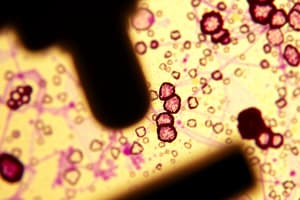Podcast
Questions and Answers
What is the chemical code that contains instructions for making proteins in the body?
What is the chemical code that contains instructions for making proteins in the body?
What do uppercase letters represent in a Punnett square diagram?
What do uppercase letters represent in a Punnett square diagram?
What refers to a situation where both alleles for a particular gene are expressed in an individual?
What refers to a situation where both alleles for a particular gene are expressed in an individual?
What is the process that forms four non-identical cells from one cell?
What is the process that forms four non-identical cells from one cell?
Signup and view all the answers
Which part of cell division was observed in the late 19th century?
Which part of cell division was observed in the late 19th century?
Signup and view all the answers
What is the main focus of the AQA GCSE Biology unit 6?
What is the main focus of the AQA GCSE Biology unit 6?
Signup and view all the answers
Which sub-unit does the Inheritance, Variation, and Evolution topic belong to?
Which sub-unit does the Inheritance, Variation, and Evolution topic belong to?
Signup and view all the answers
What does 'inheritance' refer to in the context of the AQA GCSE Biology unit 6?
What does 'inheritance' refer to in the context of the AQA GCSE Biology unit 6?
Signup and view all the answers
Which paper of the AQA Biology GCSE exam includes the unit 6 topic?
Which paper of the AQA Biology GCSE exam includes the unit 6 topic?
Signup and view all the answers
What is the broader category that includes the Understanding of Genetics and Evolution topic?
What is the broader category that includes the Understanding of Genetics and Evolution topic?
Signup and view all the answers
Study Notes
AQA GCSE Biology unit 6, Inheritance, is a topic that is included in Paper 2 for the AQA Biology GCSE exam. This unit is a part of the Inheritance, Variation, and Evolution topic, which is a sub-unit of the Reproduction topic and is a part of the Understanding of Genetics and Evolution topic as well. The unit 6 topic is a part of the AQA Biology GCSE exam and is included in Paper 2 and is a part of the Understanding of Genetics and Evolution topic as well.
The unit 6 topic is a part of the Inheritance, Variation, and Evolution topic, which is a sub-unit of the Reproduction topic and is a part of the Understanding of Genetics and Evolution topic as well. The unit 6 topic is a part of the AQA Biology GCSE exam and is included in Paper 2 and is a part of the Understanding of Genetics and Evolution topic as well.
Inheritance refers to the passing of traits from parents to their offspring. These traits can include physical characteristics, such as eye color and height, as well as behavioral traits and diseases Genes are the units of heredity that carry information about a particular trait from one generation to the next They are made up of DNA, which is a chemical code that contains instructions for making proteins in the body Dominant and recessive inheritance refer to how genes interact to determine a trait in an individual Co-dominance refers to a situation where both alleles for a particular gene are expressed in an individual, rather than one being dominant and the other being recessive Sex-linked inheritance refers to traits that are carried on the X or Y chromosome, which determine the sex of an individual
In the late 19th century, chromosomes as a part of cell division were observed, and in the 20th century, it was understood that chromosomes and units had similar behaviours. It was decided that units (now known as genes) were on the chromosomes A single gene cross looks at the probability of the offspring of two parents having certain genotypes and phenotypes. This is done using the alleles the two parents have for a gene and a Punnett square diagram Uppercase letters are used to represent dominant characteristics, and Lowercase letters represent recessive characteristics
Inheritance part 1 – Meiosis. Meiosis is the formation of four non-identical cells from one cell Inheritance part 1 – Advantages of sexual and asexual reproduction. There are advantages to both sexual and asexual reproduction. Advantages of sexual reproduction include variation in the offspring and the use of two parents to bring about genetic variation Advantages of asexual reproduction include the use of one parent and the efficient use of time
In the AQA GCSE Biology unit 6, Inheritance, students are required to understand the different types of inheritance, such as dominant and recessive inheritance, sex-linked inheritance, and the advantages of sexual and asexual reproduction. They should be able to use Punnett square diagrams to determine the probability of offspring having certain genotypes and phenotypes. They should be able to understand the formation of chromosomes and the advantages of different types of reproduction
Studying That Suits You
Use AI to generate personalized quizzes and flashcards to suit your learning preferences.
Description
Prepare for the AQA GCSE Biology exam by understanding the different types of inheritance, such as dominant and recessive inheritance, sex-linked inheritance, and the advantages of sexual and asexual reproduction. Learn to use Punnett square diagrams to determine the probability of offspring having certain genotypes and phenotypes. Understand the formation of chromosomes and the advantages of different types of reproduction.




